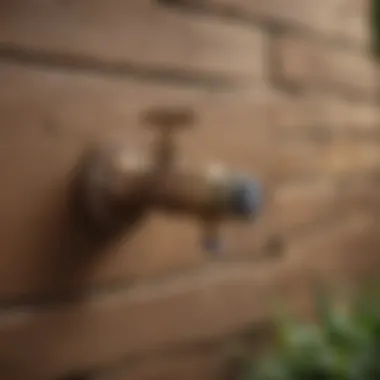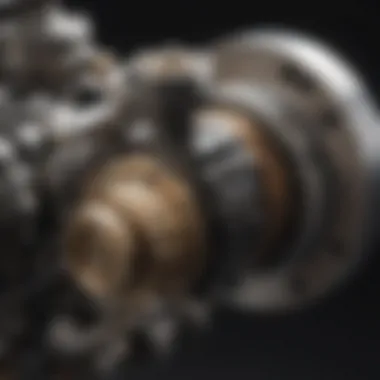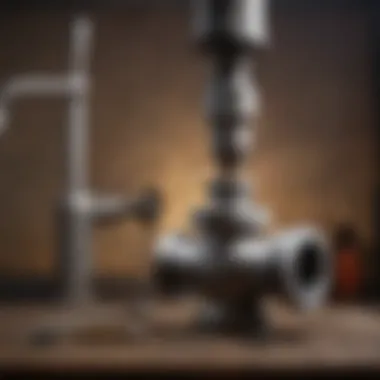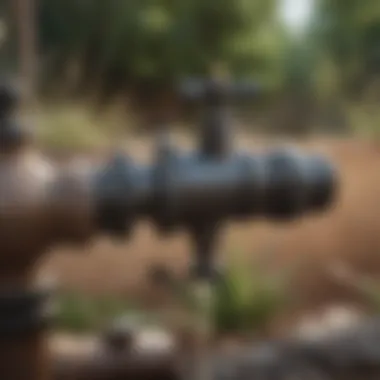Understanding Shut Off Valves for Outside Faucets


Intro
Shut off valves for outside faucets are vital components in managing water flow in irrigation systems. They play a crucial role in controlling water supply to gardens, lawns, and other outdoor areas, making them an essential feature for both homeowners and professionals in gardening and landscaping. In this section, we explore their function and significance in outdoor plumbing systems.
Understanding these valves starts with realizing their primary function—to stop or allow the flow of water to your outdoor faucets. This capability is particularly beneficial during seasonal changes or times of equipment maintenance. Using shut off valves can also contribute significantly to water conservation efforts, helping to reduce waste.
Through this article, readers will gain insights into various types of shut off valves, installation processes, maintenance recommendations, and troubleshooting strategies. Each of these elements is integral for ensuring optimal performance and longevity of outdoor plumbing systems, ultimately supporting healthier irrigation practices.
In preparing to delve deeper, it’s important to consider the various aspects surrounding shut off valves—ranging from styles and types to practical applications in real-world settings. This comprehensive guide aims to deliver nuanced understanding and practical tips, ensuring success in maintaining and optimizing outdoor water systems.
Preface to Shut Off Valves
Shut off valves serve a crucial role in outdoor plumbing systems, especially for faucets used in gardening and landscaping. These valves help regulate water flow, ensuring that it can be turned on or off as needed without affecting other parts of the plumbing system. For homeowners, understanding these elements is essential for effective water management.
Definition and Functionality
Shut off valves are mechanical devices designed to stop or allow the flow of water through a particular pipe or faucet. They operate by either opening or closing a passage, controlling water flow efficiently. When the valve is closed, water is stopped entirely; when open, water flows freely. This functionality is not merely a convenience; it is essential for tasks such as repairing leaks, winterizing outdoor systems, or managing irrigation schedules. Different types of shut off valves exist, and understanding these distinctions can lead to better decision-making and easier maintenance of one's plumbing system.
Importance in Outdoor Plumbing
In outdoor plumbing, shut off valves offer multiple benefits. First, they enable precise control over water usage, which is vital for irrigation. By being able to turn off the water supply, homeowners can prevent flooding or overwatering their gardens. Furthermore, these valves play an essential role in winter preparation. In colder climates, it becomes necessary to shut off water to prevent pipes from freezing. This not only protects plumbing components but also preserves the overall integrity of landscaping features.
In addition, the maintenance of outdoor plumbing systems benefits from the existence of shut off valves. If a leak occurs or equipment needs repairs, these valves allow for quick action without the need to shut off the water supply to the entire home. Thus, the role of shut off valves is indispensable, impacting both efficiency and conservation.
Types of Shut Off Valves
The classification of shut off valves is a fundamental aspect of outdoor plumbing. Each type serves a different purpose and is selected based on specific applications and needs. Understanding the distinctions among these valve types can significantly influence system performance, ease of maintenance, and even water conservation efforts.
Ball Valves
Ball valves are known for their straightforward mechanism and efficiency. They operate with a spherical closure element that rotates to open or close the flow. This type of valve is popular in outdoor setups due to its durability and reliability. When fully open, a ball valve provides minimal resistance to fluid flow. This efficiency minimizes pressure loss, an essential factor for irrigation systems that rely on consistent water delivery. Ball valves are also easy to operate with a simple quarter turn. Their robust construction makes them suitable for high-pressure situations.
Gate Valves
Gate valves are designed for full flow and provide minimal turbulence. These valves have a gate that rises or lowers to control water flow. While not ideal for throttling applications, they are effective for on-off control in larger pipelines. One drawback is that they can be slower to operate compared to other types, as they need to be opened or closed a significant amount before achieving full flow. Maintenance can be a concern due to their exposed parts, which can wear down over time, especially in outdoor conditions.
Globe Valves
Globe valves feature a spherical body that allows for excellent flow regulation. They are ideal for applications where precise control of flow is necessary. However, globe valves can create more pressure drop than other types. The design allows for throttling of the flow, hence making them suitable for regulating water in various landscaping tasks. Care should be taken during installation, as the orientation can affect their performance. They do require more maintenance to prevent leaks, especially in older setups.


Compression Valves
Compression valves offer a unique design that utilizes compression to control flow. They are often used in residential systems due to their ease of installation and versatility. This type is particularly helpful when dealing with variable water pressure commonly found in outdoor plumbing. Compression fittings can be easier to replace or repair than threaded types, making them user-friendly for those less experienced with plumbing. Still, they may require more frequent inspection to ensure they are functioning correctly since the compression mechanism can wear down with time.
Mechanics of Shut Off Valves
The mechanics of shut off valves for outside faucets are foundational to understanding how these components function in an outdoor plumbing setting. Recognizing the mechanics involved not only enhances the knowledge of homeowners and professionals alike but also aids in making informed decisions when selecting and maintaining these devices. Understanding how these valves operate and the factors influencing their performance can directly impact irrigation efficiency and resource management.
How Valves Operate
Shut off valves control the flow of water in outdoor irrigation systems. Their primary role is to either allow or restrict the movement of water through pipes. This action is essential for effective watering and can conserve water when not in use.
The operation of a valve typically involves the manipulation of a disc, ball, or gate. As one adjusts the valve, this mechanism moves into position to either block or open the water passage. In ball valves, for instance, a hollow, perforated sphere pivots within the valve body. In contrast, gate valves utilize a flat or wedge-shaped disk that rises or falls within the line. Each type of valve has its unique operational method but the end result remains the same: regulation of water flow.
Understanding valve operation ensures better control over your irrigation system, preventing waste and optimizing performance.
These components are usually located near the source of water – for outside faucets, this is often near the main water line or distribution point. The right operation of these valves ensures that water is delivered only when needed, significantly benefiting gardening and landscape maintenance routines.
Choosing the Right Valve
Selecting the appropriate shut off valve is essential for achieving the desired outcomes in outdoor water management. Various factors should be contemplated in making this choice:
- Purpose of Use: Determine whether the valve will be used primarily for hoses, irrigation systems, or both.
- Type of Water Flow: Assess the type of water flow required. For high-pressure systems, a ball valve might be more effective due to its quick operation and minimal pressure loss.
- Material Considerations: Valves can be constructed from diverse materials including brass, PVC, or stainless steel. Consider the environmental conditions, such as exposure to moisture, which may influence durability.
- Size and Compatibility: Ensure the valve size fits the existing plumbing system. Improper sizing can cause leaks or inefficiency in water distribution.
- Cost and Quality: Evaluate the balance between cost and quality. Investing in a higher quality valve may reduce maintenance costs and extend longevity.
Ultimately, the right choice can save resources and ensure intuitive operation. By assessing specific needs and conditions, one can arrive at a solution that meets both functional and economic expectations.
Installation Process
Understanding the installation process of shut off valves for outside faucets is crucial for homeowners and professionals alike. A proper installation ensures that these valves function efficiently, avoiding water wastage and plumbing issues. The installation method can also impact the lifespan of the valves, as well as the overall effectiveness of the irrigation system. This section will outline the materials needed and provide a step-by-step guide for installation.
Materials Required
Before beginning any installation, it is vital to gather all necessary materials. This will not only streamline the process but also prevent unnecessary interruptions. The following items are typically required:
- Shut off valve: Select the appropriate type based on your needs.
- Teflon tape: This is used to seal the threading of the valves.
- Pipe wrench: Helps in tightening or loosening pipes and fittings.
- Adjustable pliers: Useful for gripping various shapes and sizes.
- Screwdriver: Depending on the valve design, a Phillips or flathead screwdriver may be needed.
- Hacksaw or pipe cutter: For cutting existing pipes if necessary.
- Safety goggles: Always wear safety protection during installation.
Gathering these materials beforehand helps in ensuring a smooth installation with minimal complications.
Step-by-step Installation Guide
Installing a shut off valve may seem daunting, but with a clear guide, it becomes manageable. Below is a step-by-step process:


- Identify the installation point: Determine where the valve will be installed. This should be after the main water supply line.
- Shut off the water supply: Before any work begins, ensure that the water supply to the area is shut off to prevent any accidental leaks or floods.
- Cut the pipe (if necessary): Use a pipe cutter to remove a section of the existing pipe where the valve will be placed. Make sure the cut is clean to avoid any issues during installation.
- Prepare the valve: Take the shut off valve and wrap the threaded ends with Teflon tape. This will create a seal that prevents leaks.
- Install the valve: Fit the valve onto the exposed pipe ends. Ensure it is positioned correctly, with the handle in an accessible location.
- Tighten the connections: Use the pipe wrench to snugly tighten the connections. Be careful not to overtighten as this could damage the valve or pipes.
- Check for leaks: Once the installation is complete, turn the water supply back on and check for any leaks. If leaks are present, further tightening may be required.
- Test the valve functionality: Operate the valve to ensure it opens and closes properly without any resistance.
Installing a shut off valve properly protects your irrigation system and contributes to water conservation efforts.
By following these steps, you ensure a reliable and efficient installation process for your shut off valve. This knowledge not only empowers homeowners but also enhances the efficiency of outdoor plumbing systems.
Maintenance and Care
Proper maintenance and care of shut off valves for outside faucets is essential for their longevity and efficiency. Regularly attending to these components can help to prevent significant plumbing issues and promote optimal water management in outdoor settings. Neglecting maintenance leads to wear, tear, and ultimately, valve failure, which can result in costly repairs. Therefore, incorporating a clear routine for inspecting and caring for these valves is crucial for all homeowners and gardening enthusiasts.
Regular Inspection Routine
Regular inspections help identify problems before they escalate. Inspecting shut off valves should be part of seasonal preparations. Here are some key points for an effective routine:
- Visual Checks: Look for any visible signs of damage or wear. Cracks, corrosion, or leaks can indicate underlying issues.
- Operational Tests: Turn the valve on and off to ensure it operates smoothly without resistance. If it sticks, this might signal debris accumulation or internal wear.
- Check for Leaks: Pay attention to the area surrounding the valve. A dripping or pooling water suggests a need for immediate attention.
- Seasonal Preparations: Before winter, ensure valves are closed and drained to prevent freezing and cracking.
Implementing these steps regularly can dramatically prootect the overall functionality of your shut off valves. Doing this, especially before major changes in weather, prepares your plumbing systems for seasonal variations.
Cleaning Procedures
Keeping the shut off valves free from dirt and debris is equally important. Regular cleaning ensures clear passages for water flow and prevents staining or corrosion. Here are some recommended practices for effective cleaning:
- Disassemble as Needed: If your plumbing knowledge allows, consider disassembling the valve for thorough cleaning. This is not always necessary but can be useful for severe cases.
- Use a Soft Brush: Employ a soft brush to scrub away any grime. Avoid any metal bristles they can scratch and damage the valve surface.
- Flush the System: After cleaning, run water through the system to remove any remaining debris or cleaning residues.
- Check Seals and Gaskets: While cleaning, examine seals and gaskets for wear. Replacing these parts promptly can help maintain the valve’s integrity.
Incorporating both regular inspections and cleaning procedures into your maintenance routine will significantly enhance the performance of your shut off valves. Understanding the importance of this care can lead to more efficient water use and extend the life of your outdoor plumbing systems.
Troubleshooting Common Issues
Understanding common issues with shut off valves is crucial for ensuring the efficiency and reliability of outdoor plumbing systems. Homeowners often face problems that, if not addressed, can lead to wasted water and increased costs. By identifying and resolving these issues promptly, you can extend the life of your shut off valves and maintain an efficient irrigation system.
Leakage Problems
Leakage is one of the most common issues associated with shut off valves. It can be caused by several factors, including worn-out seals, improper installation, or physical damage to the valve itself. Small leaks can often go unnoticed initially, but over time, they can lead to significant water loss. Not only does this waste precious resources, but it can also increase your water bill substantially.
To deal with leakage problems, start by inspecting the valve for visible signs of water escaping. If you notice any leaks, try tightening the valve's packing nut. If the leak persists, it might be necessary to replace the washers or seals. In some cases, entire valve replacement is needed. Regular inspection can prevent major water loss and ensure that your outdoor plumbing functions effectively.
Valve Not Closing Properly
Another issue that often arises is the valve not closing properly. This problem can lead to continued flow of water even when the valve is in the off position. This can be frustrating, especially during colder months when any continuous water flow can lead to freezing and potential damage to your plumbing system.


The first step to resolve this issue is to check for any debris or buildup inside the valve that may obstruct its operation. Cleaning the valve may solve the problem. If the valve remains problematic, you might need to check for internal damage or wear. Sometimes, replacing the entire valve is the most practical solution. Regular maintenance checks greatly reduce the likelihood of this issue occurring, ensuring smooth operation.
Corrosion and Damage Control
Corrosion is a persistent enemy of shut off valves, especially in outdoor environments. Exposure to moisture, soil, and other external elements can cause metal valves to corrode over time. Corrosion weakens valves, making them more prone to leaks and failures.
To combat corrosion, consider using a corrosion-resistant valve made of plastic, brass, or stainless steel. Applying protective coatings or paint can also help shield the valve from harsh weather conditions. Regular inspections to check for rusty areas or weak points can help catch issues early before they become significant problems. If corrosion has advanced, it might be best to replace the affected valves to maintain the integrity of your irrigation system.
Regular troubleshooting and maintenance of shut off valves can save homeowners time and money while ensuring efficient water usage.
Addressing these common issues will help maintain your shut off valves and contribute to the overall efficiency of your irrigation system.
Impact on Water Conservation
Shut off valves play a crucial role in modern irrigation systems. They ensure that the flow of water can be controlled effectively, facilitating not only convenience but also significant conservation of resources. By understanding how shut off valves impact water conservation, homeowners can make informed decisions regarding their outdoor plumbing.
Role in Efficient Water Use
The efficient use of water is vital in both residential and commercial settings. Shut off valves allow users to direct water flow to specific areas. For example, when watering a garden, these valves can turn the water supply on or off at precise moments. This capability significantly reduces the amount of water wasted. When water is not running unnecessarily, the overall usage decreases, leading to lower bills and a smaller environmental footprint.
Homeowners should consider installing shut off valves in key areas. Doing so not only ensures that water only flows when needed but also allows for better control of pressure and distribution. By integrating these valves into the system, one can manage irrigation schedules better, leading to healthier plants and less water being used.
Reducing Waste with Shut Off Valves
Shut off valves contribute directly to waste reduction. They can prevent leaks that often go unnoticed, causing water to drip and waste valuable resources. Detecting leaks can be challenging, but regular checks in systems equipped with shut off valves provide an opportunity to catch problems early.
Moreover, using shut off valves allows homeowners to stop water flow immediately. This control becomes essential during seasonal changes, such as shutting down a faucet during winter to avoid freezing. By stopping water flow altogether, the risk of potential waste from broken pipes decreases.
To summarize, shut off valves not only facilitate efficient systems but also protect against waste. They support conscious water management, allowing for strategies to utilize water more effectively. This leads not only to savings in costs but also contributes positively to environmental efforts.
End
Shut off valves for outside faucets play a critical role in maintaining efficient water management within any outdoor plumbing system. This article has explored various dimensions of shut off valves, detailing their types, mechanics, installation, and maintenance. Understanding these factors is not merely an exercise in knowledge; it directly influences the effectiveness of water conservation strategies, enables efficient irrigation practices, and prevents potential damage due to leaks or freezes.
Recap of Key Points
- Definition and Importance: Shut off valves regulate water flow, thus preventing wastage and controlling water supply effectively.
- Types of Valves: Different types, such as ball, gate, and globe valves offer unique advantages, suitable for varying outdoor conditions and specific applications.
- Installation Process: Knowing the right materials and a systematic step-by-step guide to installation ensures a secure and efficient setup.
- Maintenance: Regular inspection and cleaning are essential to prolong valve life and detect issues early.
- Troubleshooting: Familiarity with common problems such as leaks or improper closures enhances the ability to maintain an effective system.
- Water Conservation: Valves contribute significantly to reducing water waste, making them essential for both ecological and economic reasons.
Final Thoughts on Valve Selection and Maintenance
Choosing the right shut off valve is paramount to achieving the best performance from your outdoor plumbing. Factors such as the type of system, local climate, and specific gardening needs should be the cornerstones of your decision-making process. Ensuring proper maintenance by regularly inspecting and cleaning valves helps to prolong their functionality and reduce unexpected failures.
Water conservation is a topic that gains importance with each passing year, and the use of shut off valves plays an understated yet significant role in this endeavor. By addressing these components, homeowners and gardening enthusiasts will be better prepared to make informed decisions regarding their outdoor faucets and irrigation systems.
"With proper knowledge and maintenance, shut off valves can transform a simple faucet into an efficient water management tool."
In summary, investing time in understanding shut off valves is a step towards better irrigation practices and more responsible water usage.



